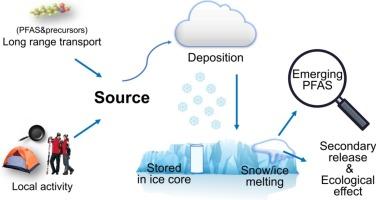Fate of ‘forever chemicals’ in the global cryosphere
IF 10.8
1区 地球科学
Q1 GEOSCIENCES, MULTIDISCIPLINARY
引用次数: 0
Abstract
The cryosphere serves as a significant sink in the global circulation of organic pollutants. Among them, per- and polyfluoroalkyl substances (PFAS), known as “forever chemical”, are of great concern as their concentrations surpass the Earth's planetary safety boundary. In this review, we synthesize knowledge on the fate of PFAS in the cryosphere, focusing on their sources, accumulation, release process, and ecological effects. Long-range atmospheric transport leads to widespread of PFAS in the cryosphere, whereas local activities are primarily responsible for the regional PFAS pollution. Because of the wide replacements of the ozone-depleting chlorofluorocarbons after the Montreal Protocol, the ultra-short chain (C < 4) PFAS, particularly trifluoroacetic acid, have emerged as the predominant compounds in the cryosphere, which may become a focus of future research. Cryospheric components such as snowfall, sea ice, and permafrost are important accumulation reservoirs of PFAS, while under climate warming, air-snow exchange, sea-ice melting and permafrost thaw lead to redistribution of PFAS. During snow/ice melt, short-chain PFAS are released earlier than long-chain PFAS. The PFAS remaining in the proglacial environment exhibit a range of ecological effects on both micro- and higher trophic organisms through the food web, ultimately leading to biodiversity loss. Our analysis shed light on the fate of PFAS in the cryosphere under climate warming and highlighted the urgent need for their long-term monitoring and study of PFAS in glacial regions to protect the fragile ice world.

全球冰冻圈中 "永久化学品 "的命运
冰冻圈是有机污染物全球循环的一个重要汇。其中,被称为 "永远的化学物质 "的全氟烷基和多氟烷基物质(PFAS)因其浓度超过地球的安全边界而备受关注。在这篇综述中,我们总结了有关 PFAS 在冰冻圈中归宿的知识,重点关注其来源、积累、释放过程和生态效应。长程大气传输导致 PFAS 在冰冻圈中广泛存在,而本地活动则是造成区域性 PFAS 污染的主要原因。由于《蒙特利尔议定书》签署后消耗臭氧的氯氟烃被广泛替代,超短链(C < 4)PFAS,尤其是三氟乙酸,已成为冰冻圈中的主要化合物,可能成为未来研究的重点。降雪、海冰和永久冻土等冰冻层成分是全氟辛烷磺酸的重要积累库,而在气候变暖的情况下,气雪交换、海冰融化和永久冻土解冻会导致全氟辛烷磺酸的重新分布。在冰雪融化过程中,短链全氟辛烷磺酸的释放早于长链全氟辛烷磺酸。残留在冰川环境中的全氟辛烷磺酸会通过食物网对微营养级和高营养级生物产生一系列生态影响,最终导致生物多样性丧失。我们的分析揭示了气候变暖条件下全氟辛烷磺酸在冰冻圈中的归宿,并强调迫切需要对冰川地区的全氟辛烷磺酸进行长期监测和研究,以保护脆弱的冰雪世界。
本文章由计算机程序翻译,如有差异,请以英文原文为准。
求助全文
约1分钟内获得全文
求助全文
来源期刊

Earth-Science Reviews
地学-地球科学综合
CiteScore
21.70
自引率
5.80%
发文量
294
审稿时长
15.1 weeks
期刊介绍:
Covering a much wider field than the usual specialist journals, Earth Science Reviews publishes review articles dealing with all aspects of Earth Sciences, and is an important vehicle for allowing readers to see their particular interest related to the Earth Sciences as a whole.
 求助内容:
求助内容: 应助结果提醒方式:
应助结果提醒方式:


